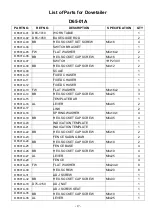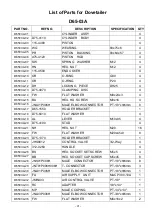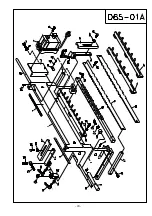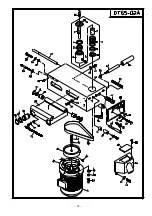
- 16 -
Preventing Chip Out
As noted previously, when the SIDE and
FRONT/BACK pieces are inserted into the machine,
they are offset a bit so they’ll match correctly when
assembled. In other words, the SIDE will rest slightly
to the right of the FRONT/BACK in the machine. This
leaves the right edge of the SIDE exposed without
the “chip breaker” effect that the FRONT/BACK
provides for the rest of the SIDE (see Figure 28). This
may result in an unsatisfactory cut at the edge of the
SIDE.
This problem is resolved simply by taking a two
inch-plus wide “back-up” board, of the same
thickness as the workpiece, and clamping it
horizontally next to the FRONT/BACK piece, so that it
backs up the exposed edge of the SIDE, as shown in
Figure 28. You can use this piece over and over
again.
Dovetails in Plywood
Because plywood handles a bit differently than solid
stock, here are some tips to follow:
1. When using plywood, the layers tend to be more
fragile. Therefore, the operator should keep the
movement of the cutting unit consistent and
proceed relatively slowly.
2. On the rounded arcs of the tenon cuts, you may
lose a bit of the top layer. This is to be expected
with plywood, and does not affect either the look or
the strength of the assembled dovetail joint.
Rather, the strength of the dovetailed corner comes
from the flat side of the tenons.
3. Plywood has a tendency to chip out on exposed
edges. A back-up board may be necessary (see
Figure 28).
Figure 28
(view from rear of machine)
Maintenance
Before doing
maintenance on the machine, disconnect it
from the electrical supply and the air supply,
and release any residual air from the lines.
Failure to comply may cause serious injury.
If the power cord is worn, cut, or damaged in
any way, have it replaced immediately.
The horizontal and vertical tables and other
exposed metal parts should be kept clean and
free of rust. A coat of paste wax will help protect
the tables from tarnishing.
After each day’s use, brush or blow out dust and
debris from the cutter, table, motor, etc.
Keep the clamping cylinders clean to prevent
debris adhering to them, which can scar
workpieces.
Keep clean the travel rods upon which the
headstock slides.
Lubrication
The linear bushings by which the headstock
travels on the rods are pre-lubricated and
sealed; they do not require additional
lubrication.
The spindle unit is also sealed and requires
no lubrication.
Occasionally check the oil level in the oil
regulator cup (see Figure 24). Add more oil as
needed. Use standard air tool oil.


























